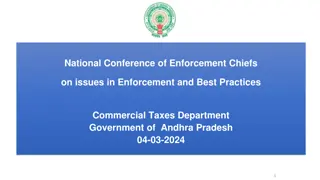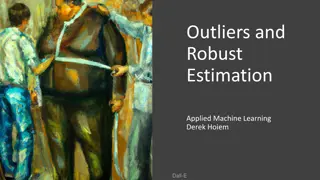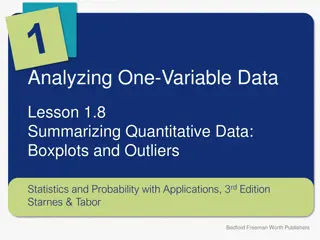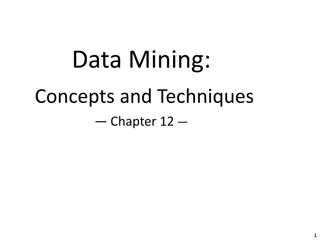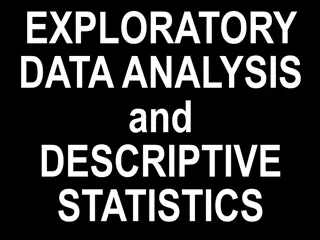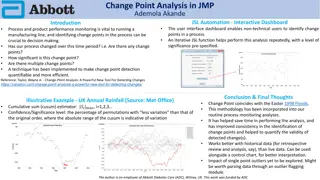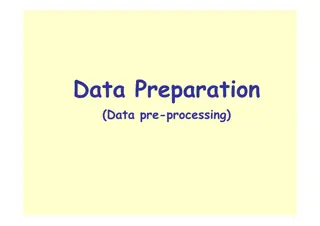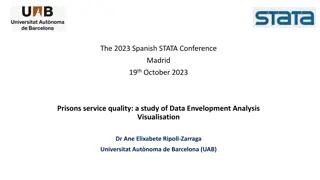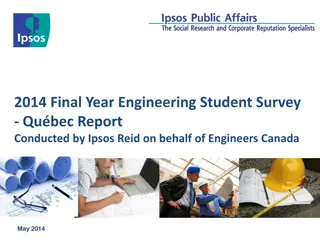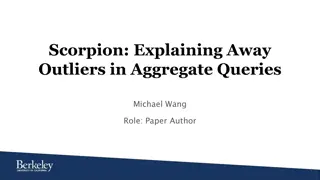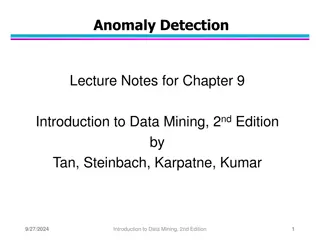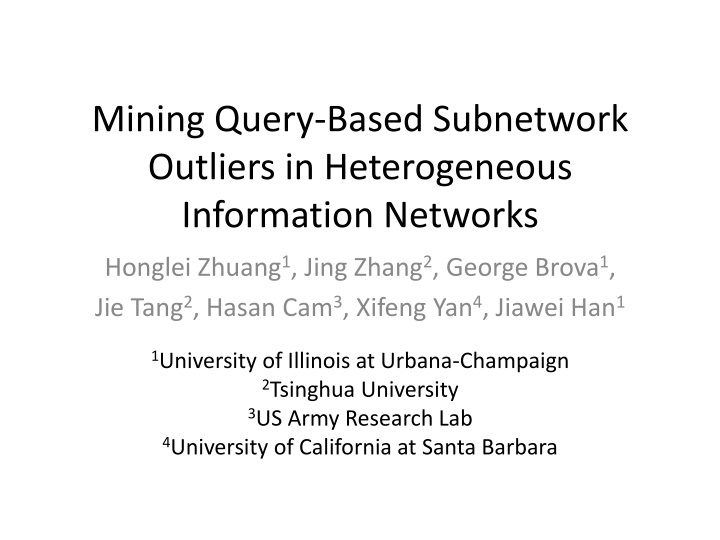
Subnetwork Outlier Detection in Heterogeneous Information Networks
Explore the methodology for identifying outliers in subnetworks within heterogeneous information networks, using query-based analysis to detect potentially suspicious activities like terrorist rings. The study delves into the process of querying subnetwork outliers in scenarios involving travel information of users, offering valuable insights into the identification of outlier subnetworks deviating significantly from others.
Download Presentation

Please find below an Image/Link to download the presentation.
The content on the website is provided AS IS for your information and personal use only. It may not be sold, licensed, or shared on other websites without obtaining consent from the author. If you encounter any issues during the download, it is possible that the publisher has removed the file from their server.
You are allowed to download the files provided on this website for personal or commercial use, subject to the condition that they are used lawfully. All files are the property of their respective owners.
The content on the website is provided AS IS for your information and personal use only. It may not be sold, licensed, or shared on other websites without obtaining consent from the author.
E N D
Presentation Transcript
Mining Query-Based Subnetwork Outliers in Heterogeneous Information Networks Honglei Zhuang1, Jing Zhang2, George Brova1, Jie Tang2, Hasan Cam3, Xifeng Yan4, Jiawei Han1 1University of Illinois at Urbana-Champaign 2Tsinghua University 3US Army Research Lab 4University of California at Santa Barbara
Suppose we are given travel information of users, including: Flight info, Hotel booking info, Car rental info, How can an analyst identify terrorists ring from the massive information? This scenario can be naturally extended to a more general problem: query-based subnetwork outlier detection.
Querying Subnetwork Outliers Input: A travel information network, a query Flights to Rio, Brazil Passenger Flight Hotel User poses a query: Analyze passenger groups flying to Rio, Brazil
Querying Subnetwork Outliers Input: A travel information network, a query Retrieve relevant subnetworks Flights to Rio, Brazil Passenger Flight Hotel User poses a query: Analyze passenger groups flying to Rio, Brazil Retrieve candidate subnetworks: connected and relevant to query
Querying Subnetwork Outliers Input: A travel information network, a query Retrieve relevant subnetworks Output: outlier subnetworks Outlier subnetwork Flights to Rio, Brazil Passenger Flight Hotel User poses a query: Analyze passenger groups flying to Rio, Brazil Retrieve candidate subnetworks: connected and relevant to query Identify outlier subnetworks: deviating significantly from others
Problem Definition Input: A heterogeneous information network A query consisting of A set of queried vertices (entities) e.g. Flight 123 Relationship from queried vertices to desired vertices e.g., passengers on the flight How they form subnetworks e.g., traveling together Output: Outlier subnetworks S G V V q Q P meta-path SP = , , S V S V 1 k
Methodology General Framework 1 2 3 Calculate similarity between subnetworks Retrieve relevant subnetworks Rank outlier subnetworks Retrieving relevant subnetworks Can be handled by IR techniques Not our focus of this work Applying a simple retrieving strategy based on frequent pattern mining 1
2 Similarity Measure Intuition: two subnetworks are similar when their members are from similar distribution over communities Basic idea: Calculate individual similarity by meta-path based similarity measure PathSim* Similarity measures (w.l.o.g, ) ( ) 1 2 1 S M S S 1 PathSim v v 2 1 ( ) = i j , max M , S S 1 2 BM ( ) j i , v v M 1 2 where is a set of pairs of vertices from two subnetworks, satisfying ( 1 1 1 1 2 , | , 1 v S v v v M = S S ) ( ) + 1 i i i j j j i j ,1 | , 1 v S v v v M 2 2 2 1 2 2 * Y. Sun, J. Han, X. Yan, P. S. Yu, and T. Wu. Pathsim: Meta-path based top-k similarity search in heterogeneous information networks. In VLDB, pages 992 1003, 2011.
Similarity Measure (cont) 2 Example S1 S2 S1 S2 S1 S2 1 1 v1 v1 v1 1 v2 v2 v1 v1 v1 1 1 1 v2 v2 v1 2 2 2 3 3 v2 v2 3 2 v2 2 v2 2 4 v1 4 v1 4 v1 Desired AvgSim *MatchSim BMSim 1.0 0.5 1.0 1.0 Desired AvgSim *MatchSim BMSim 1.0 0.5 0.5 1.0 Desired AvgSim *MatchSim BMSim <1 0.375 0.5 0.5 * Z. Lin, M. R. Lyu, and I. King. Matchsim: a novel neighbor-based similarity measure with maximum neighborhood matching. In CIKM, pages 1613 1616, 2009.
Subnetwork Outliers 3 Intuition: Clustering subnetworks by either assigning a subnetwork with an exemplar subnetwork, or classifying the subnetwork as an outlier Basic Ideas: Calculate the outlierness by ( ) 0 j ( ) = + max , S a i j i i j Automatically weighting multiple similarity measures instantiated by different meta-paths *B. J. Frey and D. Dueck. Clustering by passing messages between data points. Science, 315(5814):972 976, 2007.
Subnetwork Outliers 3 Intuition: Clustering subnetworks by either assigning a subnetwork with an exemplar subnetwork, or classifying the subnetwork as an outlier Basic Ideas: Calculate the outlierness by ( ) 0 j How good j is an exempler ( ) = + max , S a i j i i j Similarity between i and j Automatically weighting multiple similarity measures instantiated by different meta-paths *B. J. Frey and D. Dueck. Clustering by passing messages between data points. Science, 315(5814):972 976, 2007.
Data Sets #Vertices #Edges #Types Labels Synthetic 1,000 about 33,000 2 Inserted outliers Labeled for 5 queries Bibliography 3,701,765 24,639,131 4 Patent 2,317,360 11,051,283 6 N/A Synthetic + 2 real world data sets are employed Bibliography data set are constructed based on DBLP Patent data set are constructed based on US Patent data
Experimental Results Performance Data set Synthetic Bibliography Measure P@5 MAP AUC P@5 MAP AUC Ind 60.00 66.61 85.00 28.00 24.82 59.91 NB 75.00 75.76 93.68 28.00 30.20 67.87 Proposed 84.00 92.04 99.50 44.00 45.05 79.55 Baselines Ind: sum of individual outlierness NB: topic modeling with an outlier topic
Case Study Query: outlier author subnetworks related to topic modeling Proposed Method \ Ind Ind \ Proposed Method Sanjeev Arora, Rong Ge, Ankur Moitra Theory group Tu Bao Ho, Khoat Than Data mining group Giovanni Ponti, Andrea Tagarelli Name ambiguity problem for Giovanni Ponti could be an economics researcher or a data mining researcher Zhixin Li, Huifang Ma, Zhongzhi Shi Machine learning and data mining group
Summary Study a novel problem of query-based subnetwork outlier detection in heterogeneous information networks Propose a framework to tackle the problem Formalize the query Propose a subnetwork similarity Rank outlier subnetworks
Thanks 12/16/2014


